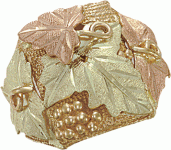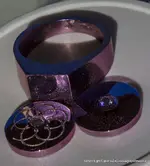In answer to your question, yes. Natural gold is normally mixed with other metals and/or minerals. Sometimes gold has been found that is .99 pure, but that's pretty rare.
There are basically two types of gold that you'll find in nature (no, jewelry isn't one of them

). There is placer gold and hard rock gold. Placer gold is what has been freed from hard rock, usually over many, many years and lots of erosion. Hard rock is just that - minerals that are still bound up in a vein within the rock of the Earth's crust.
In both instances, the gold may be "free" or "native" gold, or it may be locked up in other minerals, such as sulfides. With sulfide ores, you cannot just crush the rock and pan out the metals, but instead need to roast the ores and then crush and pan, or use chemical means to leech the metals from the rock.
The simplest mining to know is placer mining, and there's still a LOT to that! With hard rock mining, you have to know mechanics, geology, chemistry, and even metallurgy. And lastly, every location is different. The gold will still have basically the same properties, but even in a given area, gold may be 30% pure in one spot, while 100' away the gold is 80% pure. With hard rock mining, veins normally start out as oxide ores near the surface and turn to sulfide ores at depth - usually where water can gain access inside the rock.
Now going back to your question, amalgam is made up of gold and mercury. Both occur naturally - therefore, amalgam occurs naturally. Gold is commonly found mixed with silver with occasional copper, which is called electrum. Rose gold is a mix of gold and copper.



 ). There is placer gold and hard rock gold. Placer gold is what has been freed from hard rock, usually over many, many years and lots of erosion. Hard rock is just that - minerals that are still bound up in a vein within the rock of the Earth's crust.
). There is placer gold and hard rock gold. Placer gold is what has been freed from hard rock, usually over many, many years and lots of erosion. Hard rock is just that - minerals that are still bound up in a vein within the rock of the Earth's crust. 
 Haven't seen you post in a while. Yes, you're right....again! Lots of copper AND gold in the Black Hills. Got some natural copper nuggets that a friend made. Natural, meaning that the copper is not fully refined. There's still gold and trace amounts of many other metals in the nuggets. That's some of his below:
Haven't seen you post in a while. Yes, you're right....again! Lots of copper AND gold in the Black Hills. Got some natural copper nuggets that a friend made. Natural, meaning that the copper is not fully refined. There's still gold and trace amounts of many other metals in the nuggets. That's some of his below:



